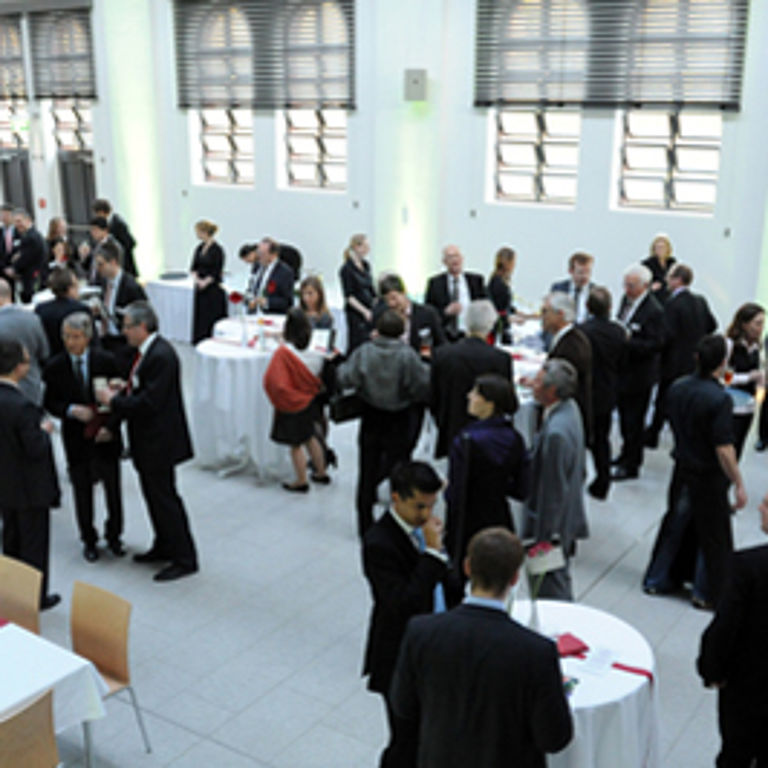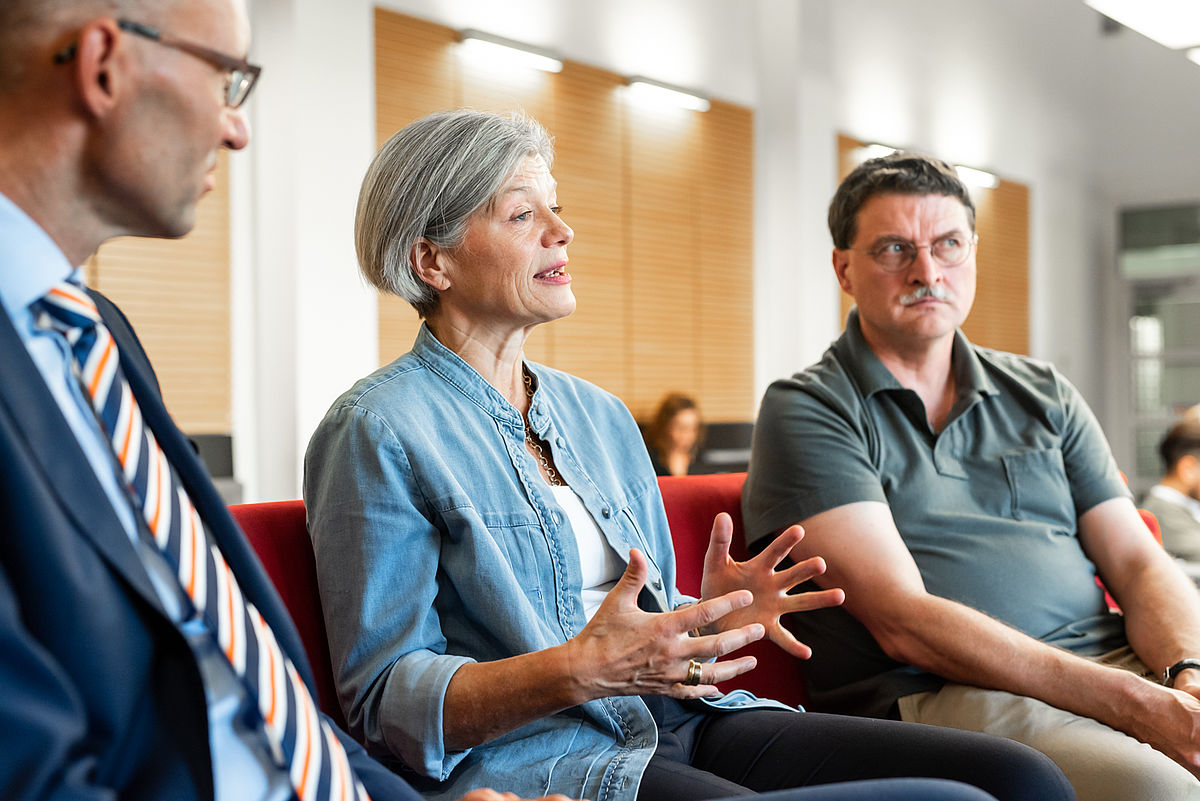Cover interview from the 02/2018 edition of Campus Passau magazine on ‘The third mission – knowledge and technology transfer at the University of Passau’.
What does transfer mean at the University of Passau?
Professor Carola Jungwirth: The University of Passau has a strong social sciences and humanities orientation. Our concept of transfer is, therefore, very broad and includes any transfer into society of knowledge gained at the university.This, of course, also includes gaining technical knowledge from the university’s research findings.
Professor Tomas Sauer: I would use a similar definition of transfer. It is about research that we transfer to a recipient outside of the university. In my view, our ability as a university to generate knowledge is often underestimated when it comes to transfer. Many of my cooperation projects came into being when our partners were faced with tasks that they were not yet able to tackle with their own resources. We were then able to use our scientific advances to develop methods that help them to secure a corresponding quality advantage.
Dr Günther Hribek: At this juncture, it is also important to mention bi-directionality as a feature of transfer. In other words, we – as a university – transfer knowledge into society, but at the same time inspiration and requirements are fed back into the university by external partners from business and society. Transfer is not a one-way street: I like to use the image of a bridge for knowledge and technology transfer.
C. Jungwirth: Transfer is one of the university’s core strategic tasks, since – as Dr Hribek says – knowledge goes in both directions. Above and beyond any questions of legitimacy, we as a university have a vital interest in developing our knowledge further with an up-to-date, future-oriented focus that is achieved by also helping society to tackle particular questions and meet challenges. I have witnessed a strong demand for the transfer services that our university has to offer, particularly in the context of digitalisation and the resulting changes to companies.
Returning to the image of a bridge, how difficult is it to make this bridge stable and encourage those on the other side to cross it as well?
G. Hribek: Comparing academia and business is an examination of two different cultures, so it is worth starting by giving each side an understanding of the other. One very simple example: companies generally want projects to be executed quickly. However, an academic may sometimes only be able to take on such a request the following semester, which is generally much too late for companies. Discussion is also required regarding what the company is expecting from the collaboration and exactly what service it is anticipating from the university. If and how easily transfer projects such as these can be initiated is heavily dependent on the amount of experience that the company and the researchers already have in this area.
T. Sauer: Having someone like Dr Hribek to provide support really is a great help. It’s important to make that clear.
Is transfer something that academics need to learn?
T. Sauer: Yes! At the FORWISS institute, we are now in the fortunate position that companies approach us because they want to work with us to implement projects. However, to go back to the image of the bridge: sometimes, the hardest thing is to bring both sides together in the middle of the bridge so that they can hold sensible discussions. And sometimes, you have to realise that, despite the best intentions, it will not be possible to work together.
Is transfer accepted as part of university scholarship’s ‘joint mission’ on an equal footing with research and teaching?
C. Jungwirth: Acknowledging transfer alongside teaching and research is a strategic decision by the University Executive. At the same time, the University Executive should be clear that not all staff can undertake transfer, teaching and research in equal measure. It is important that every faculty has a healthy combination of all three pillars, and our stated goal is to strengthen and recognise all such skills at the University of Passau.
T. Sauer: In my view, anyone wishing to undertake transfer needs a certain level of intrinsic motivation. Out of those who are willing, it is then important to take the second step of identifying those who are also able. In addition to communicating with transfer partners and understanding their problems, this also means tailoring your research in an appropriate way. Anyone not willing or able to do so should avoid transfer, as partnerships fall apart quickly if something is not working, and the university also suffers.
Dr Hribek, how does the Transfer Centre help young academics to undertake successful transfer?
G. Hribek: One major benefit of the Transfer Centre is that we have an extensive network in the region, which our scholars can draw on. We also have a lot of experience in dealing with companies and can serve as a ‘translator’ in discussions if required. For example, I can easily spot if a company representative is close to calling off a discussion, enabling me to mediate accordingly. We also help researchers to launch their transfer projects, and in particular with establishing a consortium, which for many people would otherwise represent lots of extra work.
The University of Passau’s Transfer Centre, founded as part of the Technik Plus development initiative, is a service and coordination platform that acts as an interface between academia and the practical world.
It is a central facility available to all faculties and disciplines, and it aims to promote and organise knowledge and technology transfer in interdisciplinary contexts.

The Transfer Centre is a point of contact for private and public facilities and services that want to work together with the University of Passau, and it ensures that all enquiries received and any relevant issues from business and society are forwarded to the relevant scholars and scientists. At the same time, when requested, it also supports and advises scholars and scientists at the University of Passau who want to transfer their research findings to private or public facilities and services or to society in general, or who want to foster collaborations with non-academic facilities and services. In addition, it is a reliable ‘hotbed’ for numerous start-ups that have been founded in and around the university.
The primary role of the Transfer Centre is to extend the university’s value chain from knowledge generation (research) through to the targeted relaying, application and, where relevant, the protection and use of knowledge. It seeks to bridge the gap between theoretical research and practical application by making scientific and technological findings available in a form that can be used by the business world or that provides a social benefit. The Transfer Centre is available to all faculties and disciplines, and it aims to promote and organise knowledge and technology transfer in interdisciplinary contexts.
The Transfer Centre’s tasks fall under the three areas of knowledge transfer, business start-up consultancy and continuing education (the ‘three pillars’). In terms of knowledge transfer, the Centre’s transfer activities go beyond subject, faculty and university borders and focus on creating research and development projects. Its activities target academia, society and business in equal measure. In addition, knowledge transfer includes involvement in transfer-related funding programmes on a national and EU level.
Under ‘business start-up consultancy’, the Centre provides all University of Passau students and academics who are interested in start-ups with help in the key issues relating to founding a company. This ranges from personal consultation to various funding programmes or the GZDN (Lower Bavaria Start-Up Centre for Digitalisation).
The third pillar covers continuing education activities that draw on the university’s academic competences and research findings. The University of Passau has developed an overarching concept that guides all continuing education services for external participants. It also seeks collaborations with other higher education institutions, associations and departments to make Lower Bavaria a more attractive location. Furthermore, the University of Passau’s Transfer Centre is involved in additional transfer projects as well as the Transfer and Innovation in Eastern Bavaria (TRIO) higher education institution network.
What would you say are the key ingredients for successful transfer?
T. Sauer: In my view, there are three essential elements: firstly, an interest on the part of the researcher to engage with the partner’s problems or issues as well as the partner’s readiness to approach the university. The second is trust. You have to work on equal terms and foster trust with each other. Both sides must provide information and not leave the other begging for scraps. You have to put all your cards on the table, especially for long-term collaborations. The third is infrastructure. As an academic, I need someone who understands the general environment: What does the EU grant framework have to offer? Is the project subject to VAT? How much money can and should I request? As an academic who wants to focus on my research, all of these things can often initially seem rather overwhelming, so I need the help of the Transfer Centre.
G. Hribek: Other ingredients you could add are individuality, flexibility and a problem-solving approach. When a company contacts the university or the Transfer Centre with a problem, it is generally not yet at all clear if this will be a bachelor's dissertation, a doctoral thesis, a project supported by funding or contract research. This is something that needs to be developed and it requires a lot of flexibility.
Has transfer become easier for academics or is it even more challenging than in the past?
C. Jungwirth: I suspect that there’s a bit of both. On the one hand, it has become more challenging because large companies are heavily driven by cost-benefit analysis and collaborating with a university is no longer something exclusive. On the other hand, institutional mechanisms have become more professional, and it is now much easier for researchers to obtain the infrastructure services and support that they need. In the past, these mechanisms were less rigorous and more random, whereas now there is a clearly structured process that enables both parties to interact fairly and on equal terms.
G. Hribek: I think that digitalisation offers huge potential for transfer. There have been companies where I saw opportunities for a collaboration with the university a good while ago, but nothing came of it. Then, digitalisation suddenly created so many areas of overlapping content that it became clear we should at least discuss it – and various projects have resulted.
The transfer-oriented cooperative projects INDIGO and TRIO bring together East Bavaria’s universities and higher education institutions, which are often also competing. What is the added value of collaborations like these?
C. Jungwirth: The University of Passau is a medium-sized university that does not offer a full range of subjects. It is important to network with other higher education institutions and universities to ensure successful transfer. We must synchronise in certain areas so that we can develop joint services. The Transfer and Innovation in Eastern Bavaria cooperative project – TRIO for short – and the INDIGO higher education institution network are part of this. Both endeavour to coordinate and synchronise transfer activities in East-Bavarian universities and higher education institutions.
G. Hribek: Higher education institutions can complement each other in networks with their different disciplines, and I also think that funding bodies tend to promote this form of interdisciplinary working particularly strongly. In addition, a network of higher education institutions such as this offers huge benefits from a company’s perspective. Suppose that a company contacts the University of Passau with a question that we do not have the specialist knowledge to answer: instead of having to send the company away, we can put them in touch with other academics in our higher education institution network.
T. Sauer: The core element of these collaborative projects is that everyone recognises that the others can do things that they cannot do themselves. We would be foolish not to join forces.



